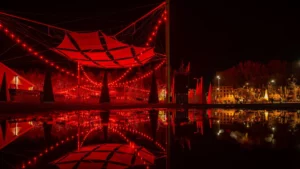At a crucial time in the evolution of one of the world’s most unique critters, Chris Viney explores the plight of the reclusive Tasmanian Devil.
At southern Tasmania’s wildlife parks and devil rescue centres, it’s easy to observe and interact with Tasmanian devils and and to learn how skilled and dedicated wildlife experts are.
Somewhere, in some remote Tasmanian forest, does the mysterious thylacine, ‘the Tasmanian tiger’ still roam the island’s wildest places? Some believers say yes. But most people accept that this mysterious and elusive creature, in its day the world’s largest carnivorous marsupial, is finally extinct.
The thylacine’s place as Tasmania’s top predator has been taken by another remarkable animal, the Tasmanian devil. Named because of the weird and terrifying screams and snarls that disturbed the peaceful sleep of shepherds and graziers in the early days of settlement, the devil now faces its own threat from a deadly contagious facial tumour disease, spread during the confrontations that occur between animals fighting over food or in the mating season.
Maybe this doesn’t sound like the kind of creature that you’d want up-close and personal but you’d be surprised. At southern Tasmania’s wildlife parks and devil rescue centres, it’s easy to observe and interact with Tasmanian devils and to learn how skilled and dedicated wildlife experts are helping to save the devil from the same fate as the thylacine.
Bonorong Wildlife Sanctuary
On the northern outskirts of Hobart at Brighton, this long-established sanctuary has expanded its role in recent years to include wildlife rescue and rehabilitation, having already trained more than 300 volunteer Friends of Carers in the right way to help native animals in need, particularly those injured on Tasmanian roads. Bonorong runs a successful breeding program for Tasmanian devils and the hand-reared devils interact in a friendly and playful way when they have established a bond with their human keepers. Led by the inspiring Greg Irons, a recent young Australian of the Year, the staff at Bonorong are passionate about the animals and birds in their care. You’re likely to come across Greg as you wander through the free-range bushland or join a guided tour to encounter wallabies, kangaroos, wombats, koalas, native birds and more as well, of course, as the sanctuary’s 15 or so Tasmanian devils.
www.bonorong.com.au
Tasmanian Devil Conservation Park
Soon after crossing Eaglehawk Neck on the way to Port Arthur on the Tasman Peninsula is the site of the world’s original Tasmanian devil experience. It’s a place where you’ll come face-to-face with a wide variety of Tasmanian native animals and birds, including the amazing tawny frogmouth ñ if you can spot it in a Eucalypt tree above you, perched motionless and disguised as a broken branch, you’re doing well! And then there are the Tasmanian devils, the real motivation behind the conservation park’s existence. At feeding time you’ll enjoy close observation of the animals and learn from the dedicated staff about the breeding programs that are helping to ensure the survival of this unique Tasmanian marsupial.
www.tasmaniandevilpark.com














